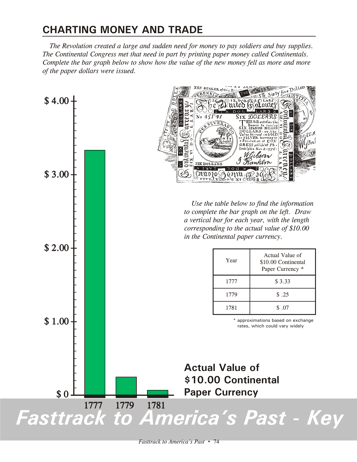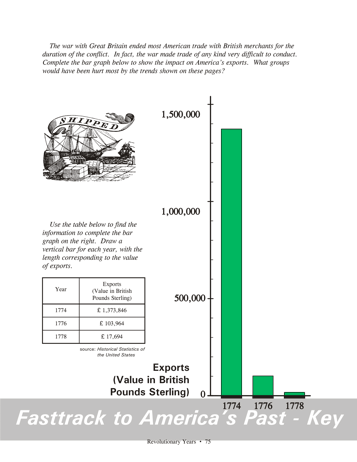| Fasttrack
to America's Past Teacher Key |
|
| Fasttrack
to America's Past Teacher Key |
|
 Page 74  Page 75 |
Pages 74
& 75 - Charting Money and Trade Both of these are
bar graphs, and students will need a color pencil to complete them. It's OK to show
students a quick preview of what the finished graphs should look
like. But insist that students work from the data in the table,
marking the top of the bars carefully based on the numbers, and then
drawing the bars. For the first graph, point out to students
that each of the small marks represents $.10 or ten cents. The
figure for 1781 is $.07 or seven cents, so the last bar will be very
short. For the second graph, point out to students
that each of
the small marks represents 100,000 British Pounds Sterling.
The figure for 1778 is 17,694 British Pounds Sterling. As a
result, the last
bar will be very short. What the chart shows, page 74 This graph shows the rapid drop in the value of paper money printed during the Revolution. Since the Continental Congress had no easy way to collect taxes during the Revolution, it resorted to printing paper money in large quantities. It is a well-understood principle of economics that when too much money is put into circulation, the value of the money falls.Saying that the value of the money is falling is the same as saying that prices are rising. The term for rising prices is inflation. The picture shows several examples of the American money printed and used during the Revolution. These bills claim that they can be exchanged for Spanish Silver Dollars. Unfortunately, the Continental Congress did not have the silver to make good on the note's promise during the Revolution. (They did pay later.)
What the chart shows, page 75 This graph shows the dollar value of the same four crops listed on the previous page. Remind students that a billion is a thousand million. Show the figure for corn on the board: $19,700,000,000. Corn is especially important and valuable to American farmers because it grows well and has many uses. The crop is used in such familiar products as corn flakes and other cereals, but is also valuable for animal feed and other purposes. (See the response for the chart question below.)Background for the chart question, page 75 Many groups in both America and in Great Britain would have been hurt by the trends shown on these two pages. As the American paper money fell in value, people holding the money lost that value. Someone selling four or five horses, for example, might find that months later the money they got in the deal could not buy even one horse. The money paid to a farmer for corn or wheat at harvest time might be worth only a fraction of that value the next spring. The drop in exports hit plantations growing tobacco, indigo, and other non-food crops especially hard. Merchants on both sides of the Atlantic saw their trade disappear. Port cities like Boston had many tradesmen, such as rope makers and sail makers, whose pay depended on the export trade. |
|
Copyright Notice
Copyright 2018 by David Burns. All rights reserved. Illustrations and reading selections appearing in this work are taken from sources in the public domain and from private collections used by permission. Sources include: the Dover Pictorial Archive, the Library of Congress, The National Archives, The Hart Publishing Co., Corel Corporation and its licensors, Nova Development Corporation and its licensors, and others. Maps were created or adapted by the author using reference maps from the United States Geological Survey and Cartesia Software. Please see the home page for this title for more information. |